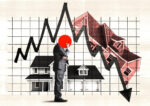Mortgage rates notched their first weekly increase in six weeks just before the new year.
The average rate for a 30-year fixed-rate loan climbed to 6.42 percent from 6.27 percent, according to Freddie Mac data reported by Bloomberg. The figure closes out a year over which mortgage rates more than doubled, pricing out potential homebuyers and locking sellers in place.
Hiigher mortgage rates “remain a significant barrier to successfully closing transactions,” George Ratiu, head of economic research at Realtor.com, told Bloomberg.
As more buyers sit on the sidelines, homes are taking longer to sell. Inventory has risen as a result, but the population of available listings is still down from the pandemic-era housing market.
The number of properties for sale has risen 18 percent since last year, according to a recent report by Redfin, for the biggest gain since 2015. However, the brokerage reported home sales dropped 35.1 percent year-over-year in November — the largest drop since it began tracking sales in 2012.
Read more



The buyer of a median-priced home would pay about 60 percent more than last year due to higher borrowing rates, or about $2,100 a month without taxes or insurance, according to Ratiu.
Mortgage rates rose following an increase in 10-year treasury bond yields, which indicated more investors were seeking a safe store for their money. A key inflation metric showed earlier this month that consumers were paying six percent more than a year ago for goods and services.
The Federal Reserve is targeting an annual inflation rate of two percent, suggesting that its campaign to stem high prices and high wages with even higher interest rates is far from over.
— Orion Jones
